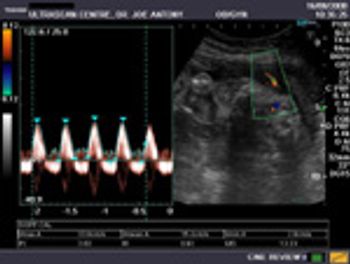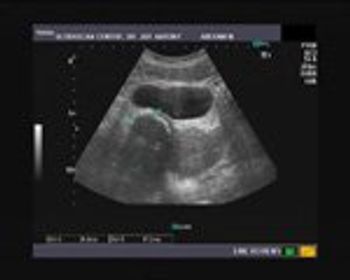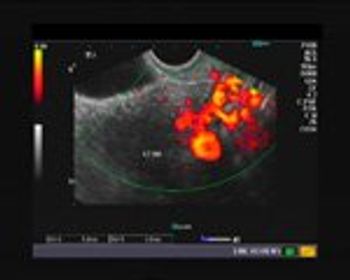
A 68 year old woman had been referred for treatment of a fibroid tumor. Due to the size she was unable to stand or walk, had dyspnea and dysuria.

A 68 year old woman had been referred for treatment of a fibroid tumor. Due to the size she was unable to stand or walk, had dyspnea and dysuria.

The fibroid is a tumor that is very frequently encountered in the uterus on both clinical examinations as well as on routine pelvic sonography.

This is the case of a routine ultrasound examination at 31 weeks gestation.

William Parker, MD discusses the use of MRI in diagnosing and managing uterine fibroids. Dr. Parker's upcoming Clinical Opinion article, “The utility of MRI for the surgical treatment of women with uterine fibroid tumors”, will be published in the American Journal of Obstetrics and Gynecology in 2012.

Microlaparoscopy is a useful tool in diagnosing various causes of pelvic pain. In this tutorial, get the basics on conscious pain mapping in gynecological surgery.

Is single incision surgery worth the increased cost, learning curve and operative time? Is it more advantageous than a standard laparoscopy?

A history of high blood pressure may be indicative of future physical as well as psychiatric problems, according to a new study published in General Health Psychiatry. The study found an association between preexisting hypertension, but not pregnancy-induced hypertension, and risk for depression.

According to some sources, there are as many as 600,000 hysterectomies performed annually in the US, making it the most common nonobstetrical surgical procedure among women in the US. While the procedure itself is relatively safe, we need to ask what are the long-term effects of a hysterectomy?

Lead researcher Dr Janet McLaren discusses the results of a new study exploring new concerns that rheumatoid arthritis, lupus, and inflammatory bowel disease may lead to premature ovarian failure and early menopause.

What is your diagnosis of this ultrasound image?

The DailyDx is one of the hottest sections. Tell us what your favorite DailyDx in 2011 was. Here are our picks, vote on them or add your favorite pick in a comment.

In an effort to clarify any misinterpretations of previous statements, the American College of Obstetricians and Gynecologists (ACOG) and the Society for Maternal-Fetal Medicine (SMFM), along with other medical and clinician groups, issued an update regarding the use of Makena (Ther-Rx Corporation; Bridgeton, Missouri) and compounded 17a-hydroxyprogesterone caproate (17P).

Most gynecologic problems require multidisciplinary treatment. An often-overlooked modality is formalized physical therapy provided by individuals trained in the treatment of gynecologic problems.

In their role as primary care physician for some women, ob/gyns must be aware of the pathophysiology, management, and prevention of urolithiasis to ensure prompt and appropriate treatment.

In short, available evidence suggests that home births are a calculated gamble that nothing will go wrong, but they occasionally sacrifice safety for aesthetics.

One letter writer said the following: ""I have long believed that the use of Barton's forceps to facilitate the delivery of the head during a cesarean delivery is a superior technique, and very much appreciated the discussion by Drs. Obican, Brunner, and Larsen in the September 2011 issue of Contemporary OB/GYN.""

Mammography screening does not save many women's lives, reports a new study. It just provides early diagnosis with no impact on mortality or it over diagnoses disease.

Women taking oral contraceptives (OCs) containing desogestrel, gestodene, or drospirenone have at least twice the risk for venous thromboembolism (VTE) as those who take OCs containing levonorgestrel.

An annual report on consumer expenditures from the US Bureau of Labor Statistics shows that a trend begun more than a decade ago is continuing: an increase in average annual consumer expenditures for healthcare.

The woman sued those involved with her care and claimed there was both failure to follow up on the fact that she was breech at 38 weeks and negligence in sending her home from labor and delivery with her complaint of contractions and a breech fetus. A defense verdict was returned.

Canadian researchers report a significant association between oral contraceptive (OC) use and the incidence of prostate cancer in a study published online November 14 in BMJ Open. MORE

Low-dose aspirin taken by healthy women to prevent heart attack and stroke may be ineffective or even harmful, a new study suggests. Even among high-risk women, 50 would need to take aspirin for 10 years to benefit 1 woman, researchers report online November 16 in the European Heart Journal. MORE

Low birth weight, slow growth during infancy, and either low or high body mass index (BMI) at 11 years of age significantly increase the risk of poor physical functioning at 60 years of age, Finnish and British researchers report. MORE

Delaying clamping of the umbilical cord until 3 minutes or longer after delivery reduces neonatal anemia and iron deficiency at 4 months of age without adverse effects, according to a Swedish study. MORE

The last decade has seen a proliferation of technologies for office-based surgery (OBS) that allow many procedures once performed in a hospital or ambulatory surgery center (ASC) to be safely incorporated into office practice. Diagnostic and operative hysteroscopy, cystoscopy, non-resectoscopic endometrial ablation, and hysteroscopic tubal occlusion are examples of procedures that have moved into the practitioner's office.

Laparoscopic surgery offers unique advantages over abdominal surgery but there are some disadvantages. What can be done to improve your surgical skills?

Breech presentation occurs in 3 to 4% of term pregnancies and it is the most frequent indication for a cesarean section.

Although the American College of Obstetricians and Gynecologists’ Committee on Obstetric Practice has stated that hospitals and birthing centers are the safest place for childbirth, some women choose to have their children in their homes.

The Centers for Disease Control recently updated their recommendations for tetanus toxoid, reduced diphtheria toxoid, and acellular pertussis vaccination (Tdap) in pregnant women.

Test your diagnostic skills!